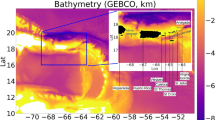Abstract
The modeling results obtained using the original version of the three-dimensional finite-element hydrostatic model QUODDY-4 testify that the spatial distributions of dissipation of baroclinic tidal energy and the related coefficient of diapycnal mixing in the deepwater stratified subdomain of the White Sea (the Basin and Kandalaksha and Dvina bays together) are highly similar to those found for low- and midlatitude oceans. It is in the open part of the sea that their values remain equal to the minimum possible values determined by the molecular kinematic viscosity; at its lateral boundaries (not all boundaries, but only individual segments (sites of mixing)), their values increase. In the shallow homogeneous subdomain of the White Sea, the dissipation of baroclinic tidal energy is considerably larger than in the deep stratified subdomain. Accordingly, the vertical eddy viscosity in the first subdomain is a few orders of magnitude higher than the coefficient of diapycnal mixing in the second subdomain. This is caused by an increased tidal velocity due to reduced depths.
Similar content being viewed by others
References
W. H. Munk, “Abyssal Recipes,” Deep-Sea Res. 13(13), 707–730 (1966).
K. L. Polzin, J. M. Toole, J. R. Ledwell, et al., “Spatial Variability of Turbulent Mixing in the Abyssal Ocean,” Science 276(5309), 93–96 (1997).
J. R. Ledwell, E. T. Montgomery, K. L. Polzin, et al., “Mixing over Rough Topography in the Brazil Basin,” Nature 403(6766), 179–182 (2000).
W. H. Munk, “Wunsch C. Abyssal Recipes II: Energetics of Tidal and Wind Mixing,” Deep-Sea Res. I 45(12), 1977–2010 (1998).
J. T. C. Ip and D. R. Lynch, QUODDY3 User’s Manual: Comprehensive Coastal Circulation Simulation Model Using Finite Elements: Nonlinear Prognostic Time-Stepping Model, Report Number NML95-1 (Thayer School of Engineering, Dartmouth College, Hanover, New Hampshire, 1995).
B. A. Kagan and A. A. Timofeev, “Dynamics and Energetics of Surface and Internal Semidiurnal Tides in the White Sea,” Izv., Atmos. Ocean. Phys., 41(4), 498–512 (2005).
St. Laurent, C. and Nash, J.D., “An Examination of the Radiative and Dissipative Properties of Deep Ocean Internal Tides,” Deep-Sea Res. II 51(25–26), 3029–3042 (2004).
Author information
Authors and Affiliations
Corresponding author
Additional information
Original Russian Text © B.A. Kagan, A.A. Timofeev, 2011, published in Izvestiya AN. Fizika Atmosfery i Okeana, 2011, Vol. 47, No. 5, pp. 693–700.
Rights and permissions
About this article
Cite this article
Kagan, B.A., Timofeev, A.A. Dissipation of baroclinic tidal energy and diapycnal mixing in the White Sea. Izv. Atmos. Ocean. Phys. 47, 642–648 (2011). https://doi.org/10.1134/S0001433811050069
Received:
Accepted:
Published:
Issue Date:
DOI: https://doi.org/10.1134/S0001433811050069



